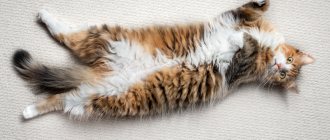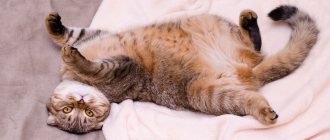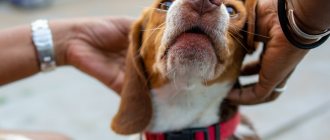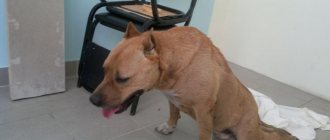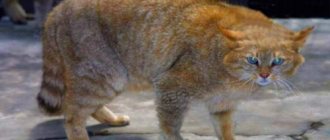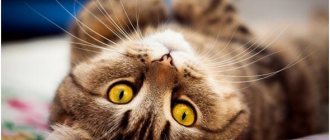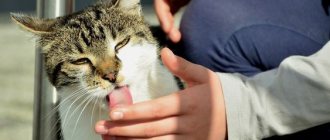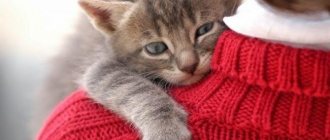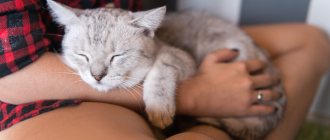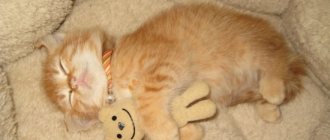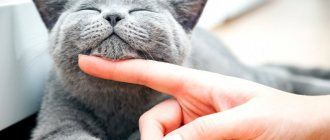5537Pavel
1
Furry pets - cats and cats - spend quite a lot of time sleeping, almost 2/3 of the day. Although this does not mean that their sleep is deep throughout this entire interval, more often it is just a nap. If the cat sleeps on its back, then it certainly sleeps soundly.
You can find out whether a purr is really sleeping by its posture and how it reacts to surrounding stimuli. Usually an animal, like a person, tries to find the body position in which it sleeps as comfortably and sweetly as possible.
It has been noticed that a kitten sleeps in the most relaxed and varied positions, and it sleeps much longer than an adult. At the same time, you should not fear for his life and health; this position on his back does not harm the cat at all.
© shutterstock
Breeding specialists and cat owners tried to deduce a certain pattern why the cat is spinning on its back. We will consider all options.
Baby pose
Sleeping on the back is associated in cats with the very first impressions in this world and the tender period of infancy:
- Mom's care . Babies end up on their backs as mother licks their tender belly with her tongue, massaging the intestines through the abdominal wall and aiding digestion. Soft and moist stimulation of the natural orifices with the tongue stimulates the emptying of the bladder and intestines, after which the kitten falls asleep contentedly.
- Childhood memory. Cats reliably associate well-fed peace and pleasant warmth with physical posture, and even as adults, they instinctively remember this connection, falling asleep on their backs with a feeling of complete peace. If a kitten climbed onto the bed and, having warmed up, fell asleep next to its owner with its paws up, it means that it associates the person with the mother cat, and the bed with its native lair and safe haven.
Pet nutrition and overeating
Many kittens like to eat often and a lot; this habit can remain in an adult. They may ask for food constantly, especially when the owners eat something the cat likes. Well, how can you refuse a sweet, kind face and such pleading eyes? And the result is banal overeating. It is after such gastronomic chaos that the cat will go to sleep on his back, with his paws outstretched. In this position, nothing will put pressure on the abdomen.
Although an overeated cat does not always take this pose. A balanced diet, a sufficient amount of vitamins and a diet make the furry beauty sleep healthy and sound. Well, how can you not fall back in a comfortable position in a comfortable place and fall into a sweet sleep? After all, he is sure that upon awakening, he will be able to again receive a portion of tasty and favorite food.
Expressing trust in a person
Given the flexibility of the spine, sleeping mustache-striped cats can bend in the most incredible ways, but if the cat leaves its belly uncovered, it means that in this house it feels safe, well-fed, calm and can allow itself to dream without fear of attack.
You can talk about unconditional trust in a person if the cat likes to sleep, turning over on its back in close proximity to the owner.
This is how a pet shows its affection, gratitude and sense of security.
General thematic information
A typical sleeping position for mustachios is curled up with their muzzle buried in their paws. The scientific name for this position is incognito style: the owner sees only the fluffy ball. Also, the animal often lies on its back without showing concern - this is the second favorite position among furry cats. The following are the most common reasons explaining why a cat took a position lying on its back.
Coziness and convenience
The explanation is simple - the cat is comfortable: he is as relaxed as possible and rests, snoring sweetly. Some furries can even snore. In this case, there are no signs of anxiety, the animal does not twitch in its sleep. If the room is warm, quiet, there are no screams or scandals, the atmosphere will also be cozy and pleasant, and a friendly environment also affects mustaches. The cat understands that he can completely relax and enjoy sleep, and takes the most intricate poses. Also, if the fluffy often lies on his back, this also indicates that there is positive energy in the home.
Love and understanding
Usatik loves his owner very much, trusting him with the most valuable things - himself and the protection of his sleep. Animals sleep soundly, lying on their backs and exposing their tummy, when they feel completely safe. The stomach for cats is the most vulnerable place: real “dared souls” leave it without cover in their sleep. Therefore, the “paws up” pose is a sign of boundless trust (especially if the fluffy sleeps next to the owner). The cat needs to be encouraged in return: to play, pamper him with goodies, and take care of his health.
Take care of your belly
The throat and belly are vital parts of the body, and exposing them leaves the animal vulnerable. With decreased vigilance and muscle relaxation, the threat increases, so in the wild, solitary felines are always on the alert.
Their sleep mainly consists of a light doze in a compact position on tucked up paws or, bending over, on their side. From this position you can instantly jump up, like an elastic compressed spring, in order to repel the enemy in time or escape.
Is the situation dangerous?
The cat can lie on its back if it has pathologies of the genitourinary system or injuries in the groin area. But at the same time, a number of alarming symptoms will be observed - meowing and restless behavior, lack of appetite, problems with going to the toilet. In such conditions, an examination by a veterinarian is required. So, if a cat likes to lie down or sleep on its back and there are no alarming symptoms, the situation does not require concern or panic. Fluffy is comfortable in this position, he relaxes and gets enough sleep. There are many reasons explaining this behavior: from ordinary comfort to overeating.
Cooling pose
If the ambient temperature is significantly higher than comfortable, the animal tries to cool itself by falling asleep on its back. The fact is that cats have their own physiological characteristics:
- They don't sweat . Like canines, representatives of the cat family lack the main saving mechanism for humans in the heat - sweat glands. Special eccrine glands are located only on the paw pads, but their function is limited to marking territory rather than effective sweating.
- Thermoregulation . You can see how Murkas breathe rapidly on a hot day and open their mouths, wash themselves and lick themselves in order to cool down due to the evaporation of saliva. However, the canine mechanism of thermoregulation due to rhythmic breathing and abundant salivation with evaporation of moisture from the oral cavity is also not the main one in cats.
- Heat transfer . The main method of heat exchange in cats in the heat is through convection: a hot body gives off heat to a less heated environment. That is why animals try to find the coolest place in the house and lie there motionless, minimizing movement and heat production. The air layer between the hairs acts like the thermal insulation wall of a thermos, so the lying “paws up” position allows you to open the least furry part of the body – the stomach – for ventilation.
- Threat of heatstroke . When the ambient temperature becomes prohibitive, compensatory mechanisms become insufficient and the body faces overheating. Animals become apathetic, insensitive to external influences and hot to the touch. In a confined, stuffy space, such as a closed car, a cat can suffer heatstroke and even die.
Signs associated with the color of cats
An important role in superstitions associated with cats is played by their color. We all know that a black cat is a harbinger of misfortune; if it crosses the road, there will be no happiness.
However, often black animals, without a single spot, become living mascots for their owners. As long as they live in the house, the owners will be healthy, and any business will bring benefit and prosperity.
What about pets of other colors?
1. It is believed that a white cat in the house attracts financial well-being. However, the British and Irish have a belief that is the opposite of the sign we are familiar with. They consider a black cat a sign of good luck and prosperity, but a snow-white animal is a harbinger of misfortune.
2. It is not customary to keep ginger cats in the house. They are believed to sow discord between family members. The only exceptions are gifted pets.
By the way, contrary to the well-known superstition, you cannot give a coin for a cat as a gift - it will not live long in the house. It is better to symbolically “exchange” it for some small thing.
3. A tricolor cat is considered a symbol of exceptional luck, health and prosperity. Moreover, this sign is equally widespread in Europe and Asia.
True, the Japanese believe that it is tricolor animals that, after living for many years in the same house, can become werewolves. To avoid this, you should not allow the animal to dance in one place.
Forced posture for illnesses
Health problems can cause forced sleep positions as the cat seeks the most comfortable body position to reduce discomfort and pain. The owner should sound the alarm if the unnatural position is accompanied by lethargy of the pet, refusal to eat, problems with natural functions, the presence of lumps in the abdomen, or plaintive meowing.
The reason for this situation may be:
- binge eating;
- bloating and intestinal diseases;
- breathing and heart problems;
- expanded tumors of internal organs and mammary glands.
An animal irritated by an illness may protect the diseased part of the body and respond with dissatisfaction and aggression to an attempt to touch the stomach or palpate it. The owner’s duty is to help a sick friend by urgently taking the animal to a veterinary clinic.
Why do cats lie on their backs with their paws outstretched?
Even though cats cannot talk, they have many ways of communicating with their owners. And one of the indicators of how your pet is feeling at the moment can be sleep. Sweet Dreams.
Cats spend more than half of their lives sleeping. Moreover, they can often sleep in a variety of positions: curled up in a ball, stretched out on their stomach or on their side. But one of the funniest and most touching positions for a sleeping cat can be called sleeping on its back with its hind legs outstretched.
Cats spend more than half of their lives sleeping.
What can such a pose of a sleeping pet tell the owner?
What does a cat's pose mean to its owner?
Let's :)) . Not just to prove you’re right, but just interesting :)). All that remains is to wait for the accumulation of material :065: .
26-10-2008, 00:07
Mine also sleeps on his back and sits very strangely: he leans back against the wall and folds his front paws over his thick belly. And even if the doorbell rings ahead of me, he rushes to open it.
And I read on one of the cat sites the opinion of a specialist that when a cat (cat) is healthy, if she is comfortable in the house, she can often sleep on her back. And this is how our Patronello sleeps
In addition to all this that is described here, each cat has its own special poses and signs that are unique to them. Take a close look at your pet and supplement these conclusions with your own observations.
Tailed meteorologist
The meteorological sensitivity of cats has been known for a long time. By carefully observing the pet's behavior, the owner can make a short-term weather forecast for the coming days:
- A cat sleeping on its back on a winter day foreshadows a blizzard and a blizzard, and in the summer - heavy rain.
- A cat's restless sleep with rolling from side to side means that the thermometer will rise sharply.
Everyday care and affectionate attitude will allow a person to find contact with an amazing animal and unravel its secrets.
Category: Interesting things about cats |
by redaktorporodakoshki
Other causes of supine position
There are a number of reasons why a domestic cat can sometimes be seen in a belly-up position. This happens in the following cases:
- Maximum relaxation. If a kitten grows up in a loving family, it has developed complete trust in its owners, therefore, it does not experience any anxiety even in such an unprotected position.
- Comfortable condition. This body position is often the most comfortable for cats, especially if they are lying on a soft surface.
- The desire to receive affection from the owner. The pet lies down with its belly up, inviting you to pet it.
- Aggression. This position is very convenient for grabbing the attacker with your front paws and trying to inflict maximum injury on him with your hind paws.
- Hot weather. During this period, you can often see the cat lying with its belly up to facilitate heat transfer.
- Binge eating. At the same time, cats do not find a place for themselves; in any position, their internal organs are compressed, and only in a position with their belly up can they relax their stomach.
- Puberty. Cats strive to take a position in which they get rid of tension in the groin as much as possible.
They rarely manage to relax in conditions of independent existence.
Common Causes
Lying on the floor, the cat strokes and scratches its back , which is accompanied by physical pleasure and relaxation. So, the most common reason for riding on your back is the desire for comfort. Don't worry about not getting enough attention; cats always strive for maximum comfort and can roll around on the floor simply because it feels good. If the behavior becomes too regular, perhaps the reason is self-soothing, that is, this is how the cat deals with stress.
Adult cats prefer a sedate lifestyle, but even the laziest four-legged cats are active for 15–20 minutes at a time. Riding on your back is an excellent warm-up for the muscles of the back and neck, which, by the way, almost never relax in cats.
While rolling on its back, your cat can brush its fur , especially if you have a long-haired pet. The fact is that when four-legged animals lick themselves, the hooks on the tongue catch the hairs, and the cat swallows them. If the fur coat is very fluffy, the tailed one has to swallow a lot of fur, which can lead to intestinal blockage ... and, in principle, not very pleasant. Usually, for combing, the cat chooses rough surfaces: carpets, sofas, rugs near doors.
The place or atmosphere in the house is too warm and the cat is too hot
Most cat breeds have thick, dense fur, so they are much hotter than humans. The supine position improves heat transfer. This is especially important in the hot season, when you want to cool down. Then the cats lie on their backs so that the abdomen, on which there is much less hair, is ventilated and the body temperature drops slightly.
© shutterstock
Why does a cat sleep on a person: what do his postures and chosen place mean?
Even though cats cannot talk, they have many ways of communicating with their owners. And one of the indicators of how your pet is feeling at the moment can be sleep. Cats spend more than half of their lives sleeping. Moreover, they can often sleep in a variety of positions: curled up in a ball, stretched out on their stomach or on their side. But one of the funniest and most touching positions for a sleeping cat can be called sleeping on its back with its hind legs outstretched.
Cats spend more than half of their lives sleeping.
What can such a pose of a sleeping pet tell the owner?
What does a cat's pose mean to its owner?
Like many other animals, in cats the stomach is the most unprotected part of the body, which they try to protect from various threats.
And usually, even during sleep, if there are people nearby whom the cat does not trust, he tries to cover his belly.
The cat covers his belly if there are people nearby whom he does not trust.
In this case, he sleeps sideways or in the classic position, curled up in a ball.
If the cat sleeps on his back, with his stomach open and his hind legs spread wide, he is very comfortable and cozy in his surroundings. He is confident that his sleep will not be disturbed by a sudden threat from which he will have to defend himself. This is why the cat serenely opens its belly while resting.
For many domestic cats, an open belly is the highest degree of trust in a person.
A cat's open belly signifies trust in the person.
Therefore, if your pet came to your side and fell asleep sweetly on its back, with its paws spread to the sides, it completely trusts you. You can verify this by stroking the belly of a sleeping cat. In the absence of trust, the animal will instantly wake up and, at best, simply change its position, hiding its stomach.
In the worst case, the pet may hiss or even use its teeth and claws to protect its personal space.
Unneutered male pets may begin to experience mild groin discomfort during puberty.
Sleeping on your back with your hind legs spread wide open helps to avoid it. Also, a cat can often sleep in this position during periods of sexual desire. An animal experiencing the reproductive instinct and not getting what it wants may experience physical discomfort associated with the groin area, as is the case with puberty.
During the period of sexual desire, the cat sleeps with its hind legs outstretched.
If it is obvious to the owners that the pet really suffers from problems related to sexual desire, they should decide to castrate it or breed it with a suitable cat.
If your pet is dozing sweetly or sleeping, lying on his back, then this may be a sign of his complete contentment with life.
If a cat sleeps on its back, it means it is happy with its life.
Other characteristic indicators of a cat’s bliss in the indicated position in sleep or half-asleep:
- completely relaxed body;
- freely hanging or lying paws;
- tightly closed or hooded eyes;
- retracted claws;
- calm breathing.
And finally, the simplest reason that a cat sleeps in this position may be banal convenience.
It is comfortable for a cat to sleep on its back.
Like people, animals have their own preferences regarding their favorite body positions during sleep: some like to relax curled up in a ball, others feel most comfortable sleeping stretched out on their side or turned on their back.
The only reason why owners should sound the alarm if a cat sleeps on its back with its paws outstretched is possible diseases of the pet’s groin or genitourinary system.
But in this case, the animal gives its owners other signals about its condition: meows, behaves restlessly, refuses to eat, or visits the toilet less often. If there are no alarming symptoms, then owners of cats who like to sleep upside down should not worry about this.
If the cat feels well and sleeps peacefully, then there is no need to worry about the cat’s sleeping position.
Very often, owners of domestic cats observe a touching picture - the cat sleeps on its back, with its paws outstretched. In most cases, this pose indicates that the furry is happy, he completely trusts his owners. And only sometimes lying on the back is a cause for concern, as it signals problems in the cat’s body. So why does a cat like to lie on its back? List and explanation of possible reasons.
The mother licks the fur of small kittens with her tongue, and pays special attention to the tummy. This serves as both a necessary hygienic procedure and a measure to prevent digestive problems in the baby. After such a massage, the kitten feels good, he is calm and completely relaxed, and quickly falls asleep. A grown pet retains this picture from childhood in its memory, and sleeping on its back gives it complete peace of mind.
A pose on his back with his paws up is a sign that the fluffy completely trusts the situation and the person. This is only possible when a warm relationship is established between the owner and the animal. The cat sees protection in a person and trusts him to guard his sleep. Also, at the same time, fluffies can bend and hang from surfaces - this is how they express complete happiness and contentment with life.
REFERENCE! An indicator of special trust: the cat lies down on the floor, turns over on its back and begins to “stretch” in front of the owner.
Cats have a sensitive spine, they need a soft surface for sleep and complete relaxation. Lying on its back there is no pressure on the spine, the animal enjoys.
The heat and stuffiness “falls” the cat onto its back and forces it to spread its paws in different directions, since in this position the body cools down faster. This is explained by the fact that heat exchange in the abdominal area occurs faster due to the smaller volume of wool. Cats in this position “ventilate”.
Typical for uncastrated male cats. The animal feels discomfort in the groin, and an open posture with paws up helps reduce tension and discomfort caused by excitement.
After the cat has had enough, he craves rest and relaxation. And here a problem arises: curling up because of a full belly or lying on your paws is uncomfortable or even painful. Therefore, the animal falls on its side or lies on its back so that nothing puts pressure on its full belly.
This is a subjective but possible factor. Cats with long, thick and dense hair often sleep on their backs. And individuals with sparse and small fur usually sleep in a ball or on their paws.
Lying on your back can also serve as a signal about the development of certain pathologies. These can be diseases of the intestines, kidneys, inflammatory processes in the body. The cat falls on its back, while it does not allow its owners to approach it, does not allow it to be touched (attempts to palpate the stomach will cause attacks of aggression in the animal). There are also additional symptoms:
- lack of appetite;
- stool disorders;
- constant meowing;
- general lethargy or restless behavior.
If such signs are present, urgent consultation with a veterinarian is necessary. A series of tests and treatment may be required.
So, if your pet furry loves to lie on his back and there are no suspicious symptoms, there is no reason to worry. With this pose the animal shows its trust and happiness. Lying on your back is also comfortable in hot weather or after a heavy meal. But you should be wary if the cat is lying on its back, but at the same time lethargic, painful, and apathetic. In such a situation, immediately visit the veterinarian.
When a cat climbs onto your lap or lies down next to you, it shows its affection and affection. When a domestic cat sleeps in its owner's bed, it uses it as a warm place with a familiar smell. He is calmer when he feels the closeness of his owner, and at the same time the cat is sure that this is how he controls the person.
Cat and man
It is important for cats to take part in the life of the owner and be part of the events that happen. By lying down in a person's place, his clothes, or jumping into his arms, they feel in the thick of things, and with the help of smell they receive additional information.
When a cat rubs against a person and his things, she leaves her scent and accepts him as a member of her pack. Especially if the kitten was separated from its mother early, this is exactly how it perceives the person. The cat worries about him and if he senses problems in his body, he lies down on the weak spot, sharing his healing energy.
For reasons unknown to humans, a cat likes to fall asleep not in a cat house, but in a human bed or in a chair. Pregnant women most often experience discomfort when an animal sits on their stomach. They worry that the pet will cause harm by the pressure of its weight on the developing fetus. And some are afraid that the cat feels some kind of deviation. In fact, the animal is simply leaning against a warm and living place.
Pet behavior
If a kitten is used to sleeping in its owner's bed, this behavior becomes a bad habit for a domestic cat. It is difficult to wean him from getting into a person’s bed, although he has long stopped trembling and freezing. Having become an adult and independent (in his opinion), the cat still feels vulnerable during sleep. And since he sleeps most of his life, the owner’s smell calms him down and gives him a feeling of security. A person is many times larger than his pet, and the animal feels confident and invulnerable under his protection.
When settling down on a chair or sofa, the animal experiences similar emotions, but since the sheet and blanket smell most strongly of a person, the pet prefers to sleep on the bed.
There is also a scientific explanation for why a cat lies down on certain places on the owner’s body. Looking for the warmest place, the cat finds it where the person’s temperature is elevated. The disease always begins with inflammation and increased temperature in the diseased part of the body and neighboring tissues. If the owner has a stomach ache, the cat lies down in this place. They twist their knees - the pet curls up on its owner’s legs.
Some cat owners notice that after their cat sleeps in their bed at night, they feel much better. They are confident that the animal has cured or taken over their weakness.
Friendly homely atmosphere
Note that in a house where peace and tranquility reigns, where there is no place for scandals and quarrels, even cats feel good and cozy. This is the climate that is favorable for animals. A quiet, measured life makes the kitten calm and balanced, and this is reflected in his sleep. Or rather, in serene poses that one can only be touched by. High-quality nutrition, good care, and complete care are reflected in comfort. The pet feels that nothing can disturb its sweet sleep and therefore relaxes and plunges into it. And the pose on the back is proof of this.
© shutterstock
